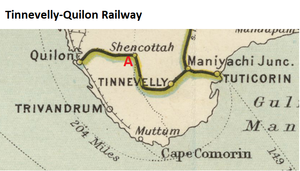Tinnevelly-Quilon Railway: Difference between revisions
HughWilding (talk | contribs) New Page |
No edit summary |
||
| (11 intermediate revisions by the same user not shown) | |||
| Line 1: | Line 1: | ||
The '''Tinnevelly-Quilon Railway''' (TQR) was divided into a British section (a state line worked by a company) and a section owned and worked by | [[File:Tinnevelly-Quilon Railway.png|thumb|'''Tinnevelly-Quilon Railway''']] | ||
The '''Tinnevelly-Quilon Railway''' (TQR) was a metre gauge([[Rail_gauge_#Metre_Gauge|MG]]) railway divided into a British section (a state line worked by a company) and a section owned and worked by the [[Princely states|Princely ]] [[Travancore|Travancore State]]. This railway is also known as '''Travancore Railway'''<ref name=name/> | |||
The route of the railway was first surveyed by [[Ernest Ifill Shadbolt]] between the years of 1888 and 1893. (see 'Personnel' below) | |||
The British Section from [[Tinnevelly]] to Kallidaikurichi, 19 miles(30km) opened in 1902 and extended to the British Frontier near Shencottah, a further 31 miles(50km) in 1908. The line was worked by ‘[[South Indian Railway]]’(SIR). | |||
<ref name=name>[https://archive.org/stream/BombayBarodaAndCentralIndiaRailwaySystem/Bombay_Baroda_And_Central_India_Railway_System#page/n156/mode/2up " Administration Report on the Railways in India – corrected up to 31st March 1918"; Superintendent of Government Printing, Calcutta; pages 148-150 ]; Retrieved 28 Jan 2016</ref> | |||
The Native (Indian) State Section from [[Quilon]] to Punalur, 28 miles(44km) opened in June 1904 and extended to the [[Travancore|Travancore State]] frontier near Shencottah, a further 30 miles(48km) later that year. The line was worked by ‘[[South Indian Railway]]’(SIR). This section involved construction of the ‘[[Aryankavu Bridge]]’, marked A in red on map.. | |||
The railway was further extended reach in 1913 to reach [[Trivandrum]], known as the the '''[[Trivandrum Extension Railway]]'''. | |||
==Records== | |||
Refer to FIBIS Fact File #4: “Research sources for Indian Railways, 1845-1947” - available from the [http://www.fibis.org/store/fibis-books-and-publications/bff-0004-research-sources-for-indian-railways-1845-1947/ Fibis shop]. This Fact File contains invaluable advice on 'Researching ancestors in the UK records of Indian Railways' with particular reference to the [[India Office Records]] (IOR) held at the [[British Library]] | |||
An on-line search of the IOR records relating to this railway <ref>[http://searcharchives.bl.uk/primo_library/libweb/action/search.do?vid=IAMS_VU2 “British Library Archives and Manuscripts Catalogue” - Search]; Retrieved Jan 2016</ref> | |||
gives the following: - | |||
*'''L/F/8/16/1095''' “South Indian Railway Company Limited, Contract as to the construction and working of the Pamban Branch and the Travancore Branch; 1901" | |||
*'''L/F/8/19/1444''' “South Indian Railway Company Limited, Contract as to construction and working of extension to Trivandrum of the Travancore Branch; 1913" | |||
==Personnel== | |||
No Staff Lists have been found. | |||
The “Indian Biographical Dictionary” gives [[Ernest Ifill Shadbolt]], [[Public Works Department]], Executive Engineer from 1888 to 1893 as 'Engineer-in-Chief of the Tinnevelly-Quilon Railway Survey ''also Bezwada-Madras and Madura-Pamban Railway Surveys'' ' <ref>[https://en.wikisource.org/wiki/Page:The_Indian_Biographical_Dictionary.djvu/430 “Indian Biographical Dictionary” 1915 page 390]; Retrieved on 27 May 2016</ref> | |||
== References == | |||
<references /> | |||
==Further Information== | |||
See '''[[South Indian Railway]]''' | |||
<br>and '''[[South_Indian_Railway_-_Lines_Owned_and_Worked#SIR_System_Metre_Gauge |South Indian Railway – Metre Gauge – Travancore Railway]]''' | |||
<br>and '''[[Aryankavu Bridge]]''' | |||
[[Category:Railways]] | [[Category:Railways]] | ||
[[Category:State Railways]] | [[Category:State Railways]] | ||
[[Category:Indian States Railways]] | |||
Latest revision as of 10:36, 14 December 2020

The Tinnevelly-Quilon Railway (TQR) was a metre gauge(MG) railway divided into a British section (a state line worked by a company) and a section owned and worked by the Princely Travancore State. This railway is also known as Travancore Railway[1]
The route of the railway was first surveyed by Ernest Ifill Shadbolt between the years of 1888 and 1893. (see 'Personnel' below)
The British Section from Tinnevelly to Kallidaikurichi, 19 miles(30km) opened in 1902 and extended to the British Frontier near Shencottah, a further 31 miles(50km) in 1908. The line was worked by ‘South Indian Railway’(SIR). [1]
The Native (Indian) State Section from Quilon to Punalur, 28 miles(44km) opened in June 1904 and extended to the Travancore State frontier near Shencottah, a further 30 miles(48km) later that year. The line was worked by ‘South Indian Railway’(SIR). This section involved construction of the ‘Aryankavu Bridge’, marked A in red on map..
The railway was further extended reach in 1913 to reach Trivandrum, known as the the Trivandrum Extension Railway.
Records
Refer to FIBIS Fact File #4: “Research sources for Indian Railways, 1845-1947” - available from the Fibis shop. This Fact File contains invaluable advice on 'Researching ancestors in the UK records of Indian Railways' with particular reference to the India Office Records (IOR) held at the British Library
An on-line search of the IOR records relating to this railway [2] gives the following: -
- L/F/8/16/1095 “South Indian Railway Company Limited, Contract as to the construction and working of the Pamban Branch and the Travancore Branch; 1901"
- L/F/8/19/1444 “South Indian Railway Company Limited, Contract as to construction and working of extension to Trivandrum of the Travancore Branch; 1913"
Personnel
No Staff Lists have been found.
The “Indian Biographical Dictionary” gives Ernest Ifill Shadbolt, Public Works Department, Executive Engineer from 1888 to 1893 as 'Engineer-in-Chief of the Tinnevelly-Quilon Railway Survey also Bezwada-Madras and Madura-Pamban Railway Surveys ' [3]
References
- ↑ 1.0 1.1 " Administration Report on the Railways in India – corrected up to 31st March 1918"; Superintendent of Government Printing, Calcutta; pages 148-150 ; Retrieved 28 Jan 2016
- ↑ “British Library Archives and Manuscripts Catalogue” - Search; Retrieved Jan 2016
- ↑ “Indian Biographical Dictionary” 1915 page 390; Retrieved on 27 May 2016
Further Information
See South Indian Railway
and South Indian Railway – Metre Gauge – Travancore Railway
and Aryankavu Bridge